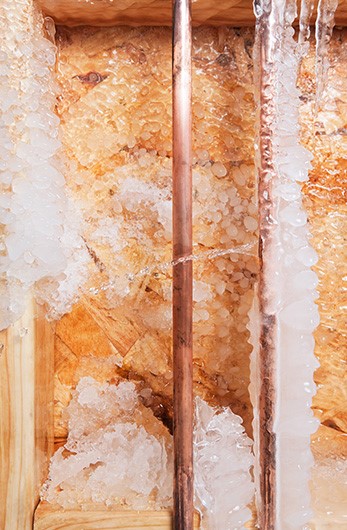This winter, don’t let pipe freezing destroy the comforts of your home
These days, the term “frozen” may bring to mind a glistening animated wonderland, stirring ironic feelings of warmth and magic. But pair it with “pipes,” and that’s another tale altogether—one that’s all too real.
Like plowed-in driveways and coughs that won’t quit, the threat of frozen pipes can be a serious source of winter angst. Why does this phenomenon happen? It starts with the science of ice. Though cold is typically associated with shrinking, water is unique in that it expands as it freezes. Freezing water creates intense pressure that can cause a pipe to reach its literal breaking point. When a frozen pipe bursts, the result can range from costly to catastrophic.

If this occurs, day or night, Noonan Energy’s emergency services are just a phone call away. But before this seasonal problem becomes a disaster, you can take measures to freeze it in its tracks.
Protecting your pipes
A pipe’s risk for freezing and subsequent bursting has little to do with its “strength” or the material from which it’s made. Metal or plastic, old or new, no pipe is immune to this potential winter woe.
The primary factors that affect a pipe’s vulnerability are location and degree of exposure. Naturally, exterior pipes are at high risk. This would include swimming pool supply lines, sprinkler lines or pipes for any exterior plumbing, as well as pipes running against or inside a home’s exterior walls. Exposed pipes in unheated areas of the home, such as the basement or crawl spaces, are also particularly susceptible.
Before winter takes hold:
- Drain outdoor water lines. Remove water from swimming pool, sprinkler and other outdoor supply lines. Do not use antifreeze unless the pipe manufacturer directs; this can be harmful to people, pets and the environment.
- Winterize hose bibs. Close inside valves that supply any outdoor hose bibs, but leave outside valves open. This will allow any remaining water to drain, or to freeze without bursting the pipe. Drain garden hoses and store them indoors.
- Insulate. Seek out pipe insulation products, such as pipe sleeves and UL-Listed heat tape. Also, ensure proper insulation of exterior walls themselves.
All winter long:
- Embrace the drip. In very cold weather, don’t shut off your faucets to maximum tightness. Allow a bit of water to drip to help prevent freezing.
- Don’t touch that dial. During winter months, it’s important to keep the heat on 24/7. This may challenge your cost- and energy-saving instincts, but it’s a critical measure for preventing potentially devastating damage from a burst pipe. Aim to keep the thermostat at a consistent temperature day and night. If your home is unoccupied during colder months, the American Red Cross advises keeping the thermostat set to at least 55°.
Suspect a frozen pipe? Don’t let it go
If your bathroom or kitchen faucet produces little or no water in frigid weather, you may have a frozen pipe. Heed its warning with these steps:
- Keep the faucet on. The flow of water, even a trickle, will help.
- Thaw the pipe using a hair dryer, heating pad, space heater or hot water-soaked towel. Never use a flame or flammable materials. Continue thawing until water returns to full pressure.
- If you cannot locate, access or thaw the pipe, call Noonan at 800-343-8829 to reach a licensed plumber.
If a pipe bursts, call Noonan immediately, and request emergency services. Our experts can quickly minimize damage and advise on next steps.
With a few safety measures in place, you and your family can help keep the fun in frozen—and enjoy a warm and magical winter of your own. For more information on our full line of home comfort services, call 800-343-8829 or visit noonanenergy.com.

